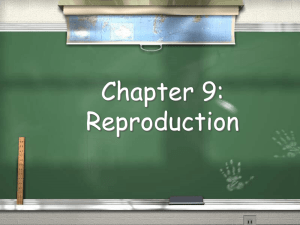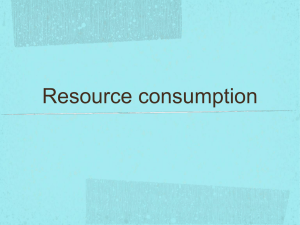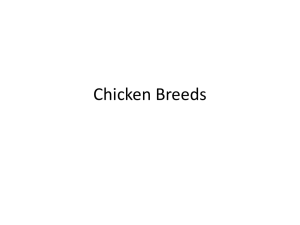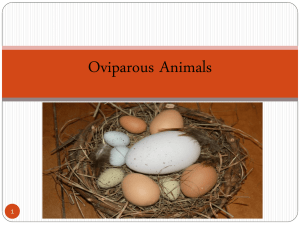Chemical (and other) stress in DEB. 2) Toxicokinetics
advertisement
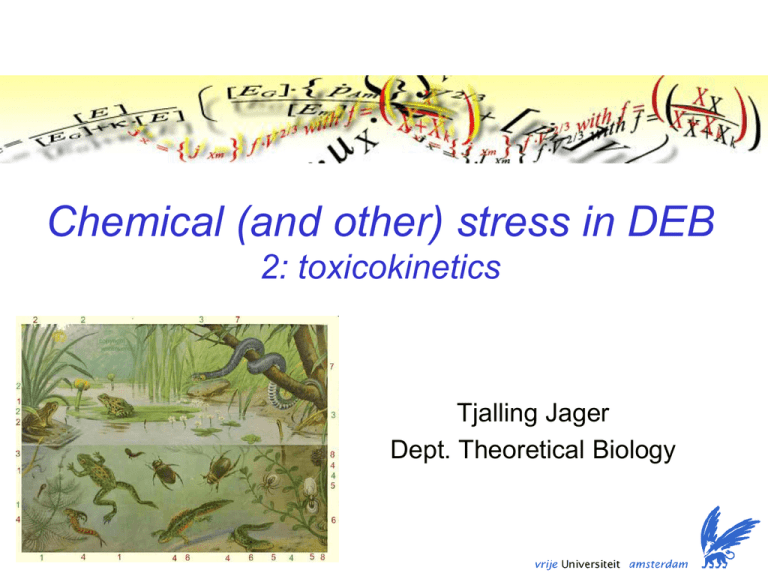
Chemical (and other) stress in DEB 2: toxicokinetics Tjalling Jager Dept. Theoretical Biology Contents Toxicokinetics The one-compartment model and diffusion Effects of composition and reproduction Complications: toxicants in soil and feeding “Biology-based” modelling toxicodynamics external concentration (in time) toxico-kinetic model internal concentration in time process model for the organism toxicokinetics effects on endpoints in time “Biology-based” modelling external concentration (in time) toxico-kinetic model internal concentration in time toxicokinetics Toxicokinetic modelling Quite popular in (eco)toxicology and pharmacology Models differ in complexity Start from diffusion Let’s assume … • well-mixed homogeneous cube with water, in a solution • cube has a semi-permeable membrane • exchange proportional to area and concentration difference Start from diffusion Let’s change the cube … • the same cube, now filled with oil ... • correct one concentration with partition coefficient between oil and water Start from diffusion Let the cube grow … • without changing the shape • leads to dilution and change in surface:volume ratio Diffusion in organisms Let’s move to an organism … • • • • can we talk about internal ‘concentration’? can we assume it is ‘well-mixed’? what is the surface area for exchange? when size and composition is constant … One-compartment model Model is a classic, and often fits well … Scaled concentration Problem • often, internal concentrations are not measured … • or not relevant for effects Effects data contain information ... • effects over time provides info on build up of body residue • but, no information about absolute levels concentration external scaled internal time Adding some realism Organisms may grow ... • dilution of concentration • change of surface:volume ratio “Biology-based” modelling external concentration (in time) body size growth toxico-kinetic model internal concentration in time process model for the organism effects on endpoints in time Active uptake Uptake/elimination of chemicals may be active • ions such as metals, nutrients • chemicals may be metabolised, or bound No difference as long as: • uptake flux external concentration • elimination flux internal concentration But ... • active processes can saturate • possible link to metabolic processes More realism Body composition may change • reserve density changes with food level and toxicants • females build up a reproduction buffer Females may reproduce • chemicals can be transferred to eggs reserve water structure buffer eggs More realism Assumptions • • • • distribution chemical over internal compartments is fast reserve, buffer and egg have same composition only structure exchanges with environment chemicals from buffer are transferred to egg reserve water structure buffer eggs More realism reserve water structure buffer eggs Reproduction buffer Assumptions • chemical follows reserves associated with eggs • rest remains in buffer overhead buffer eggs remainder reserve chemical Simulations structural length physical length 0.2 0.2 0.15 0.15 cumul. reproduction 5000 4000 3000 0.1 0.1 2000 0.05 0 0.05 0 20 40 time 60 0 1000 0 concentration structure 20 40 time 60 0 concentration reserves 4 4 3 3 3 2 2 2 1 1 1 0 20 40 time 60 0 0 20 40 time 60 20 40 time 60 concentration total 4 0 0 0 0 20 40 time 60 Simulations structural length physical length 0.2 0.2 0.15 0.15 cumul. reproduction 5000 4000 3000 0.1 0.1 2000 0.05 0 0.05 0 20 40 time 60 0 1000 0 concentration structure 20 40 time 60 0 concentration reserves 15 15 10 10 10 5 5 5 0 20 40 time 60 0 0 20 40 time 60 20 40 time 60 concentration total 15 0 0 0 0 20 40 time 60 Simulations structural length physical length cumul. reproduction 0.2 0.2 0.15 0.15 3000 0.1 0.1 2000 0.05 0.05 1000 0 0 20 40 time 60 0 4000 0 concentration structure 20 40 time 60 0 concentration reserves 15 15 10 10 10 5 5 5 0 20 40 time 60 0 0 20 40 time 60 20 40 time 60 concentration total 15 0 0 0 0 20 40 time 60 Simulations structural length physical length cumul. reproduction 0.2 0.2 0.15 0.15 3000 0.1 0.1 2000 0.05 0.05 1000 0 0 20 40 time 60 0 4000 0 concentration structure 20 40 time 60 0 concentration reserves 30 30 25 25 25 20 20 20 15 15 15 10 10 10 5 5 5 0 20 40 time 60 0 0 20 40 time 60 20 40 time 60 concentration total 30 0 0 0 0 20 40 time 60 Reproduction buffer Assumptions • chemical follows reserves associated with eggs • rest remains in buffer overhead buffer remainder eggs Simulations structural length physical length cumul. reproduction 0.2 0.2 0.15 0.15 3000 0.1 0.1 2000 0.05 0.05 1000 0 0 20 40 time 60 0 4000 0 concentration structure 20 40 time 60 0 concentration reserves 15 15 10 10 10 5 5 5 0 20 40 time 60 0 0 20 40 time 60 20 40 time 60 concentration total 15 0 0 0 0 20 40 time 60 Simulations structural length physical length cumul. reproduction 0.2 0.2 0.15 0.15 3000 0.1 0.1 2000 0.05 0.05 1000 0 0 20 40 time 60 0 4000 0 concentration structure 20 40 time 60 0 concentration reserves 50 50 40 40 40 30 30 30 20 20 20 10 10 10 0 20 40 time 60 0 0 20 40 time 60 20 40 time 60 concentration total 50 0 0 0 0 20 40 time 60 Simulations structural length physical length cumul. reproduction 0.2 0.2 0.15 0.15 3000 0.1 0.1 2000 0.05 0.05 1000 0 0 20 40 time 60 0 4000 0 concentration structure 20 40 time 60 0 concentration reserves 20 20 15 15 15 10 10 10 5 5 5 0 20 40 time 60 0 0 20 40 time 60 20 40 time 60 concentration total 20 0 0 0 0 20 40 time 60 What happens in an egg? During the embryonic phase … • mass is lost so concentration increases • if PEV > 1, conversion reserve to structure increases concentration structure even more • how does egg exchange toxicants with surroundings? water overheads maintenance ?? reserve reserve structure structure Assumptions realistic? Difficult to say ... Most test setups avoid growth, reproduction and changes in feeding status ... Some support: • Russell et al 1999: lipid-normalised concentrations in fish and eggs are similar • Daley et al 2009: fish eggs increase in fugacity of PCBs over incubation This extension takes the DEB assumptions to their logical consequences • with a minimum of additional parameters “Biology-based” modelling external concentration (in time) body size growth reserves reproduction rate buffer handling toxico-kinetic model internal concentration in time process model for the organism (and toxicant effects on them) effects on endpoints in time “Biology-based” modelling internal concentration in time external concentration (in time) toxico-kinetic process model model for the organism effects on endpoints in time More extensions? Plenty of options to make it more complex … • • • • • uptake from food/inhalation saturating uptake or elimination biotransformation more compartments (as in PBPK) ... Summarising TK models range from simple to complex • simplest is scaled one-compartment model with constant composition (1 parameter: ke) DEB offers logical links to include effects of growth, reserve and reproduction • one-compartment model with varying parameters • TK becomes closely integrated with the DEB organism • toxicants can affect their own TK …


